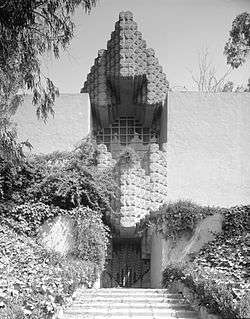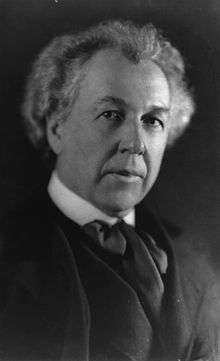Lloyd Wright
Frank Lloyd T. Wright, Jr. (March 30, 1890, Oak Park, Illinois – May 31, 1978, Santa Monica, California), commonly known as Lloyd Wright, was an American landscape architect and architect, active primarily in Los Angeles and Southern California. His name is frequently confused with that of his more famous father, Frank Lloyd J. Wright, Sr..
Early years
Lloyd Wright's mother was Frank Lloyd J. Wright, Sr.'s first wife, Catherine Lee "Kitty" Tobin-Wright. He was the eldest son of the couple, and grew up in the surroundings of the 1889 Wright home and studio in Oak Park. Lloyd briefly attended the University of Wisconsin in Madison, before leaving for a job at the Boston-based landscape architecture firm of the Olmsted Brothers. Specializing in botany and horticulture, he continued to pursue the interrelation of landscape and buildings through his life.
He settled in Southern California around 1911, followed by his younger brother John Lloyd T. Wright. The Olmsteds had sent him to assist with the landscape design of the 1915 Panama-California Exposition in San Diego with architects Irving Gill, Bertram Goodhue, and Carleton Winslow. The exposition's principal buildings and gardens still remain in Balboa Park. Landscape design led him to work with Los Angeles architect William J. Dodd and in San Diego with Irving Gill, the latter another master architect and mentor to his design career.
Beginning in 1919, his father, working in Japan on the Imperial Hotel, delegated some of the responsibilities to him and architect Rudolf Schindler for designing and supervising construction of the Hollyhock House, in Hollywood, California. The house was commissioned by the oil heiress and philanthropist Aline Barnsdall.
Wright began his independent career in 1920. In 1922 he was a production designer at Paramount Studios, responsible for the extensive castle and 12th-century village sets for the Douglas Fairbanks version of Robin Hood.
In December 1922, Wright prepared plans for the Henry Bollman House in Hollywood that included a repeated pattern of concrete blocks, a precursor to his father's more famous "textile block" houses in the Los Angeles area.[1] From 1923 through 1926 the younger Wright was drawn into the realization of these four houses, and the ambitious attempt to evolve the "textile block" system into a patented construction technique. The first was the 1923 Millard House in Pasadena, where Lloyd designed the grounds, and contributed an adjacent studio building in 1926. Lloyd served as construction manager for the other three: the Storer House (1923), the Samuel Freeman House (1923), and the Ennis House (1924). By all accounts Lloyd's work was difficult as he shuttled back and forth between sites, communicating with his father via telegram, and receiving little constructive support from Taliesin.
Independent work
Wright designed and built a number of houses in the Hollywood and Los Feliz districts of Los Angeles in the mid- to late 1920s. His first important house there was for the mother of his second wife Helen Taggart, the Taggart House, a registered Los Angeles Historic-Cultural Monument located next to the city's Griffith Park. Another significant project was the hillside house for the manager of film star Ramón Novarro, and then a renovation and enlargement when Novarro himself acquired the residence. The dramatic and theatrical Mayan-inspired John Sowden House has become his most iconic structure and is usually regarded as his best work. He also designed and built his own home with a ground floor studio and second floor residence, using concrete blocks, in West Hollywood in the 1920s.

He also designed the second and third band shells at the Hollywood Bowl. The original 1926 shell, designed by the Allied Architects group, was considered unacceptable both visually and acoustically. Wright's 1927 shell had a pyramidal shape and a design reminiscent of southwest American Indian architecture. (According to Charles Willard Moore, it was built from leftovers from the Robin Hood production.) Its acoustics generally were regarded as the best of any shell in Bowl history. But its appearance was considered too avant-garde, or perhaps only ugly, and it was demolished at the end of the season. His 1928 wooden shell had the now-familiar concentric ring motif, covered a 120-degree arc, and was designed to be easily dismantled. Unfortunately it was neglected and ruined by water damage, making way for the 1929 Allied Architects shell, which stood until the end of the 2003 season.
In 1927, Wright built a residence for himself, made of two units – one for living and one for work. The 2,413 square feet of living space has an upstairs residence with a living room, a fireplace and wooden floors. Interlocking blocks with a stylized Joshua tree design overlay some of the windows.[2]
The Great Depression stalled Wright's firm as he was reaching his artistic and professional peak. As for many architects, remodellings, rather than total designs, were the scope of 1930s work. His post-war designs became more expressionistic and less aligned to previous modernist architectural themes.
The largest collection of Lloyd Wright buildings in the United States was built in phases (1946–1957) for the Institute of Mentalphysics, located on a large Mojave Desert site next to the town of Joshua Tree, to the east of Joshua Tree National Park.[3]
Later work
His best-known project is the Wayfarers Chapel, also known as "The Glass Church", an indoor/outdoor structure made almost entirely of glass and built in 1951 for the Swedenborgian church, overlooking the Pacific Ocean on the Palos Verdes Peninsula. The site planning and planting design express his talent and experience as a landscape architect. He had an embracing grove of Redwoods (Sequoia sempervirens) planted to achieve this. The building is listed in the National Register of Historic Places.
When the trees that surround the Chapel grow up, they will become the framework, become a part of the tree forms and branches that inevitably arise from the growing trees adjacent to it. I used the glass so that the natural growth, the sky, and sea beyond became the definition of their environment. This is done to give the congregation protection in services and at the same time to create the sense of outer as well as inner space.
Among his last projects was the 1963 John P. Bowler house, known as the "Bird of Paradise" House, in Rancho Palos Verdes using blue fiberglass for projecting roof fins, and the master plan and building designs for a 1970 shopping center in Huntington Beach, at Warner and Springdale streets south of Long Beach.[4]
Personal life
In 1922 Wright married the actress and artist Elaine Hyman (known as Kyra Markham),[5] but they divorced in 1925.
The following year Wright married Helen Taggart, the daughter of a client. (Her then seven-year-old son, Rupert Pole, would later marry Anaïs Nin.) In 1929 Lloyd and Helen became the parents of architect Eric Lloyd Wright, who has consulted on the restoration of many of his father's and grandfather's works, as well as being independently creative. Lloyd Wright died in 1978 in Santa Monica, California.
A comprehensive monograph on Lloyd Wright and his work, "Lloyd Wright, the Architecture of Frank Lloyd Wright, Jr.", has extensive vintage and contemporary photographic documentation of his projects[6]
Work

- Otto Bollman House, Hollywood, 1922
- Taggart House, Hollywood, 1922-1924
- landscape design for the Millard House, Pasadena, 1923
- Oasis Hotel, for Pearl McCallum McManus, Palm Springs, California, 1923-1926 (razed)
- John Sowden House, Los Feliz, Los Angeles, 1926
- studio adjacent to the Millard House, Pasadena, 1926
- Samuel-Novarro House, Hollywood, 1926[7]
- bandshells for the Hollywood Bowl, 1926 and 1927 (destroyed)
- house and teaching studio of Jascha Heifetz, Beverly Hills, 1940 (the studio reconstructed as part of the Colburn School in downtown Los Angeles)
- Ramona Gardens housing project, Los Angeles, 1940 (with others)
- Aliso Village housing project, Los Angeles, 1941-1942 (with others)
- renovation of the Hollyhock House for conversion into a USO facility, and subsequent restoration efforts, 1946 and after
- multiple buildings for the campus of the Institute of Mentalphysics, near Joshua Tree, California, 1946-1957
- Wayfarers Chapel, Rancho Palos Verdes, California, 1951 and after
Notes
- ↑ Wright in Hollywood, Robert Sweeney
- ↑ Lauren Beale (February 16, 2015), Lloyd Wright's live-work space in WeHo finds a buyer Los Angeles Times.
- ↑ jtrcc.org
- ↑ Greetings from Huntington Beach. A Surf City Mystery
- ↑ "Kyra Markham". Tera Foundation for American Art. Retrieved 20 December 2011.
- ↑ Weintraub 1998
- ↑ Beale, Lauren (December 1, 2014). "Lloyd Wright-designed Samuel-Novarro House sells in Hollywood Hills". Los Angeles Times. Retrieved 26 April 2016.
- Obituary, Los Angeles Times, June 2, 1978, p. D1
Bibliography
- Weintraub, Alan; Hines, Thomas; and Wright, Eric Lloyd: "Lloyd Wright, the Architecture of Frank Lloyd Wright, Jr."; United Kingdom publisher: Thames and Hudson, 1998; and United States publisher: Harry N. Abrahms, 1998. 595 illustrations, 275 pages, (ISBN 9780810939967)
External links
- laokay: Directory of L.A. region project locations.
- Institute of Mentalphysics
- Edward Weston, R. M. Schindler, Anna Zacsek, Lloyd Wright, Lawrence Tibbett, Reginald Pole, Beatrice Wood and Their Dramatic Circles for much on Wright's early relationships with his first wife Kirah Markham, Reginald Pole, Beatrice Wood, William J. Dodd and others.
- Tina Modotti, Lloyd Wright and Otto Bollman Connections, 1920 for much on Wright's early projects for Otto and Harry Bollman and connections with Tina Modotti.
- Irving Gill, Homer Laughlin and the Beginnings of Modern Architecture in Los Angeles, Part II, 1911-1916 for much on Lloyd Wright's early mentorship by Irving Gill and William J. Dodd.
